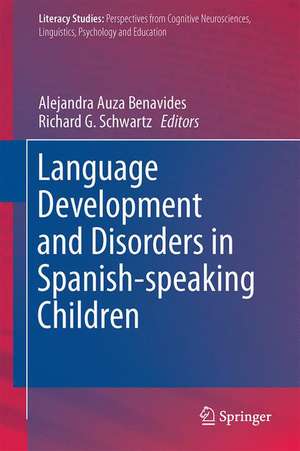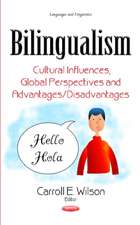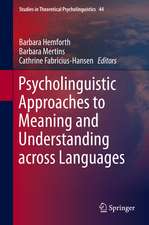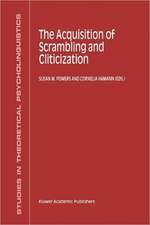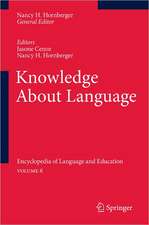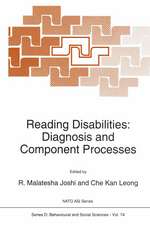Language Development and Disorders in Spanish-speaking Children: Literacy Studies, cartea 14
Editat de Alejandra Auza Benavides, Richard G. Schwartzen Limba Engleză Hardback – 22 iun 2017
| Toate formatele și edițiile | Preț | Express |
|---|---|---|
| Paperback (1) | 700.75 lei 6-8 săpt. | |
| Springer International Publishing – 12 aug 2018 | 700.75 lei 6-8 săpt. | |
| Hardback (1) | 954.45 lei 6-8 săpt. | |
| Springer International Publishing – 22 iun 2017 | 954.45 lei 6-8 săpt. |
Din seria Literacy Studies
- 18%
 Preț: 955.25 lei
Preț: 955.25 lei - 18%
 Preț: 968.65 lei
Preț: 968.65 lei - 15%
 Preț: 645.47 lei
Preț: 645.47 lei - 5%
 Preț: 1100.85 lei
Preț: 1100.85 lei - 18%
 Preț: 886.40 lei
Preț: 886.40 lei - 15%
 Preț: 651.02 lei
Preț: 651.02 lei - 15%
 Preț: 640.88 lei
Preț: 640.88 lei - 18%
 Preț: 786.84 lei
Preț: 786.84 lei - 15%
 Preț: 701.72 lei
Preț: 701.72 lei - 24%
 Preț: 802.74 lei
Preț: 802.74 lei - 15%
 Preț: 651.84 lei
Preț: 651.84 lei - 18%
 Preț: 890.68 lei
Preț: 890.68 lei - 18%
 Preț: 946.41 lei
Preț: 946.41 lei - 15%
 Preț: 638.57 lei
Preț: 638.57 lei - 18%
 Preț: 944.36 lei
Preț: 944.36 lei -
 Preț: 427.49 lei
Preț: 427.49 lei - 20%
 Preț: 620.45 lei
Preț: 620.45 lei - 18%
 Preț: 905.06 lei
Preț: 905.06 lei - 15%
 Preț: 635.65 lei
Preț: 635.65 lei - 15%
 Preț: 639.41 lei
Preț: 639.41 lei - 20%
 Preț: 564.51 lei
Preț: 564.51 lei - 15%
 Preț: 637.93 lei
Preț: 637.93 lei - 15%
 Preț: 654.12 lei
Preț: 654.12 lei
Preț: 954.45 lei
Preț vechi: 1163.97 lei
-18% Nou
Puncte Express: 1432
Preț estimativ în valută:
182.63€ • 190.68$ • 151.15£
182.63€ • 190.68$ • 151.15£
Carte tipărită la comandă
Livrare economică 05-19 aprilie
Preluare comenzi: 021 569.72.76
Specificații
ISBN-13: 9783319536453
ISBN-10: 3319536451
Pagini: 330
Ilustrații: XVII, 355 p. 36 illus.
Dimensiuni: 155 x 235 mm
Greutate: 0.7 kg
Ediția:1st ed. 2017
Editura: Springer International Publishing
Colecția Springer
Seria Literacy Studies
Locul publicării:Cham, Switzerland
ISBN-10: 3319536451
Pagini: 330
Ilustrații: XVII, 355 p. 36 illus.
Dimensiuni: 155 x 235 mm
Greutate: 0.7 kg
Ediția:1st ed. 2017
Editura: Springer International Publishing
Colecția Springer
Seria Literacy Studies
Locul publicării:Cham, Switzerland
Cuprins
PART I: TYPICAL LANGUAGE DEVELOPMENT IN MONOLINGUAL AND BILINGUAL CHILDREN.- Typical Language development of monolingual Spanish-speaking children by Sonia Mariscal & Alejandra Auza Benavides.- Language development in bilingual Spanish-Catalan children with and without Specific Language Impairment: A longitudinal perspective by Eva Aguilar-Mediavilla, Lucia Buil-Legaz, Raül López-Penadés & Daniel Adrover-Roig.- Bilingual and monolingual children’s patterns of syntactic variation: Variable clitic placement in Spanish by Naomi L. Shin, Pablo E. Requena, & Anita Kemp.- PART II: CHILDREN AT RISK OF LANGUAGE DISORDERS.- Executive functions and language development in preterm and full-term children by Miguel Pérez-Pereira, Manuel Peralbo & Alberto Veleiro.- Processing speed on infants with high and low communicative skills by Elda Alicia Alva Canto & Paloma Suárez Brito.- Relevance of family psychosocial environment in the language development of Mexican children by Izazola Ezquerro Silvia, Mandujano Valdés Mario, Rivera González Rolando, Sierra Cedillo Antonio, Figueroa Olea Miriam, Soler Limón Karla, Villanueva Romero Yadira.- Language delay and amount of exposure to the language: two (un)related phenomena in early Spanish-Basque bilingualism by María José Ezeizabarrena & I. García Fernández.- PART III: CHILDREN WITH SPECIFIC LANGUAGE IMPAIRMENT.- Neurocognitive and psycholinguistic profile of SLI: A research study on comorbidity of Specific Language Impairment with/without reading disabilities by Dolors Girbau.- Connections between language knowledge, language processing, and nonlinguistic cognitive processing in bilingual children with Language Impairment by Kerry Danahy Ebert & Giang Pham.- Sentence repetition in typical and atypical Spanish-speaking preschoolers who are English language learners by Gabriela Simón-Cereijido.- The role of verb semantic representation in sentence processing in children with SLI by Llorenç Andreu & Mònica Sanz-Torrent.- Self-repair timing of lexical problem sources. A window into Primary Language Impairment online processing by Wendy Fabiola Lara Galindo & Cecilia Rojas Nieto.- Narrative comprehension and language skills in Chilean children with Specific Language Impairment by Carmen Julia Coloma & María Mercedes Pavez.- Working memory and morphosyntax in children with Primary Language Impairment by Andrea Chávez & Alejandra Auza.- PART IV: CHILDREN WITH SYNDROMES AND OTHER LANGUAGE DISORDERS.- Morphological profile of Williams syndrome: typical or atypical?by Eliseo Diez-Itza, Verónica Martínez, Maite Fernández-Urquiza, & Aránzazu Antón.- Language skills in Down syndrome by Natalia Arias & Julia B. Barrón-Martínez.- Vocabulary and cognitive flexibility in people with Down syndrome by Octavio García, Beatriz Castillo-Ignacio, Natalia Arias-Trejo.
Textul de pe ultima copertă
Prominent researchers from the US, Mexico, Chile, Colombia and Spain contribute experimental reports on language development of children who are acquiring Spanish. The chapters cover a wide range of dimensions in acquisition: comprehension and production; monolingualism and bilingualism; typical development, children who are at risk and children with language disorders, phonology, semantics, and morphosyntax. These studies will inform linguistic theory development in clinical linguistics as well as offer insights on how language works in relation to cognitive functions that are associated with when children understand or use language. The unique data from child language offer perspectives that cannot be drawn from adult language. The first part is dedicated to the acquisition of Spanish as a first or second language by typically-developing children, the second part offers studies on children who are at risk of language delays, and the third part focuses on children with specific language impairment, disorders and syndromes.
Caracteristici
Offers original empirical studies in children's acquisition of Spanish as a first or second language Covers information from children who develop typically, children at risk, and children with language disorders Brings together contributions from different theoretical and clinical perspectives
